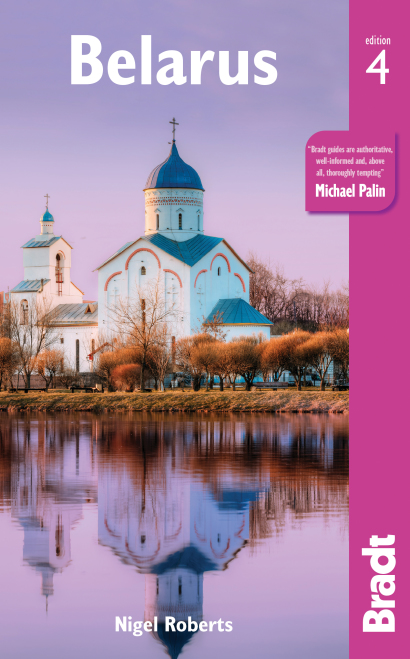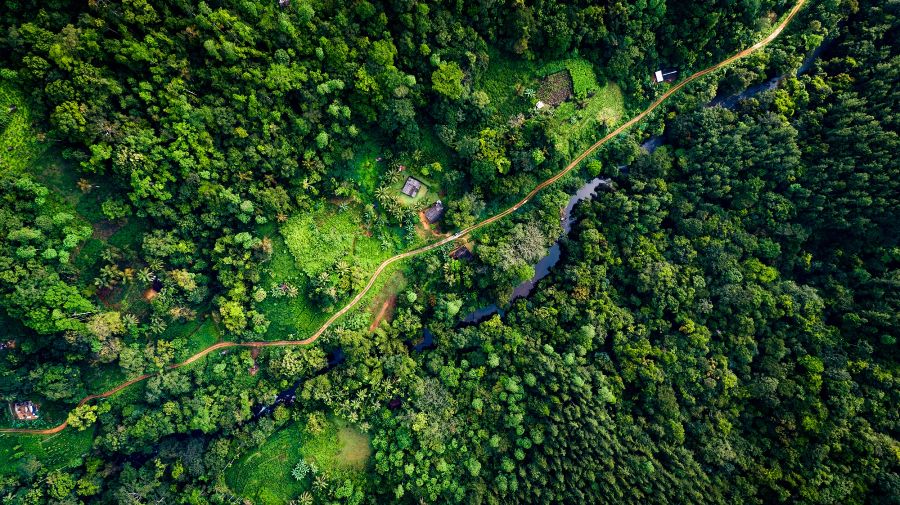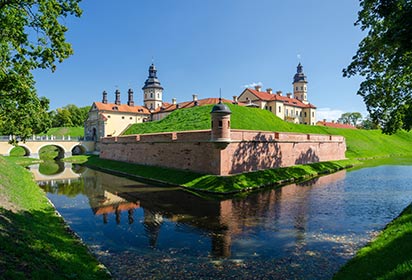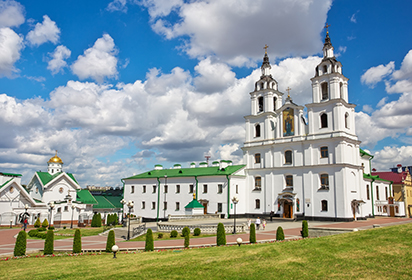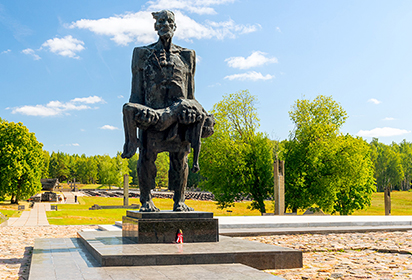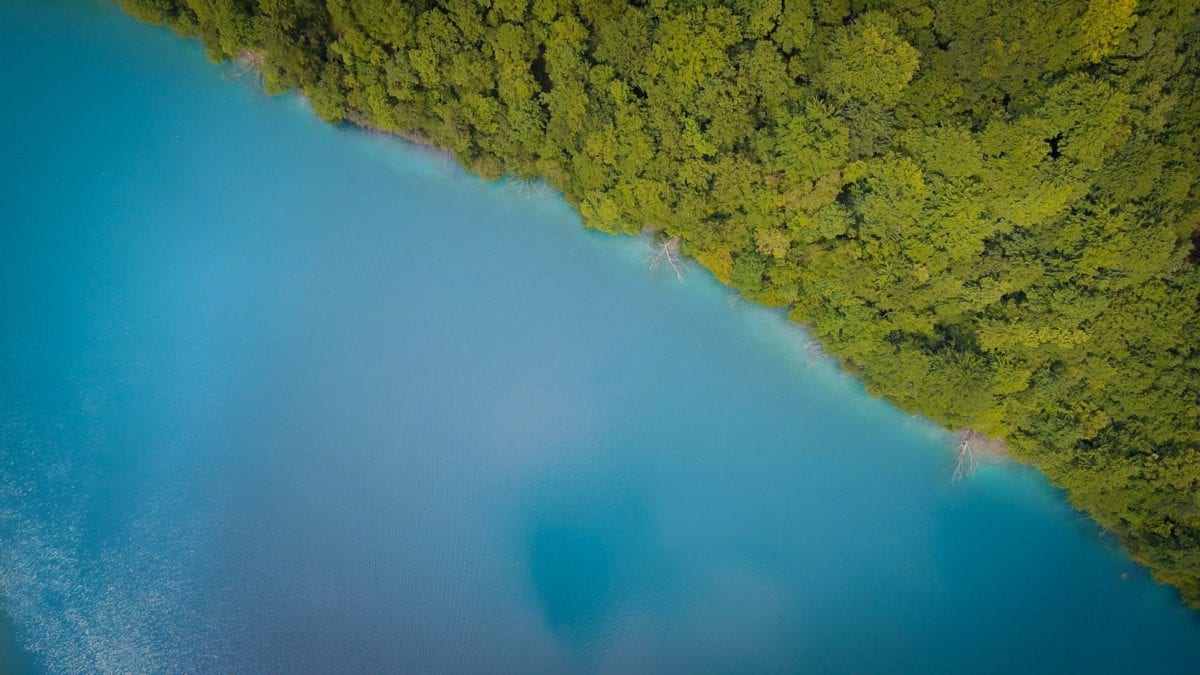It is an undiscovered box of gems, with a history rich in heroism, tragedy and despair, natural wonders of great beauty and a people who have endured endless privations over the centuries.
Nigel Roberts, author of Belarus: The Bradt Guide
The fall of the Berlin Wall and the disintegration of the Soviet Union that inexorably followed behind brought huge change to eastern Europe, not least with the birth of new nation states. Belarus is one such country. It may still be an infant, but its guiding ideals are firmly rooted in the folkloric traditions it espouses.
Despite garnering international attention following the Chernobyl nuclear disaster, it has quietly declined Western materialism and instead, stayed true to much that typified the old USSR. But a look beyond the cliché brings dividends, for there is much to discover in this greatly misunderstood and misrepresented country, where enigma and contradiction are everywhere to be found.
Explore elegant palaces like Njasvizh and Mir, experience the mystery of exquisite golden-orbed Russian Orthodox churches, and wander the ancient byways of primeval forest where wolf and bison continue to roam. We’re sure that come the end of your trip you’ll be raising a glass of vodka with the locals in celebration of this stalwartly Soviet republic.
I’m writing these words as I ride the rails down to the south-east of the country. I’m sharing a compartment with a Leningrader who is going home. She will have another 15 hours on this train after I get off. We’ve exchanged pleasantries in Russian and now we’re sharing tomatoes and cucumbers from her bag of provender. Last week I walked into Belarus by crossing the 500 yards of no-mans-land that marks the border with Lithuania. I felt like a character in a black-and-white Cold War movie from the 1960s.
There is so much to see and experience here that you can’t find anywhere else in Europe. It’s a box of wondrous treasures. We can help you to open it.
For more information, check out our guide to Belarus:
Food and drink in Belarus
Drink
It will come as no surprise that this section begins with a few words about vodka (водка). Virtually all of the countries in this part of the world lay claim to being the first to distil this spirit of mythical status, each claim probably having as much validity as the others. Whatever the truth, it’s an inescapable fact that vodka distillation is big business. Every supermarket and shop has row upon row of vodka bottles of all shapes and sizes, varying widely in quality and price. It’s usually colourless and free of flavourings, although there is a huge market around the world for spirits flavoured with so-called complementary additives such as pepper, honey, grasses and fruit (eg: lemon, raspberry or cranberry). Most people in Belarus drink it straight and unflavoured, as do I. There is an active market in home-distilled vodka and people out in the country are particularly inventive when it comes to making use of organic material for this purpose, usually potatoes. It often tastes surprisingly smooth but can be astonishingly high in alcohol content, so if offered, by all means give it a try but do treat it with extreme caution and absolute respect. I’ve experienced a few terrible hangovers after a night of domashnaya (‘home’) vodka. But I have never drunk it without knowing its source or being able to trust the founder of the feast.
Beer (пиво) is popular as a staple alcoholic drink for recreational consumption. Much of it is bottled or cask-conditioned, but there is a growing trend for local micro-breweries to produce their own diverse range of craft beers of high quality. If you’re an aficionado, you will have no difficulty in sourcing an increasing number of excellent examples and ‘beer bar’ or ‘beer pub’ are signs you will find in increasing numbers around towns and cities as the country reaches out to welcome incoming visitors from abroad as well as offering a different type of night out for locals.
Food
The cuisine of Belarus derives from the same historical and cultural sources as those of its neighbours and is an articulation of the people’s relationship with the land. So if you’ve travelled in Russia, Ukraine, Poland and the Baltic states you will recognise dishes and recipes that are common to each. For generations, local people have grown their own produce, particularly potatoes, root vegetables and fruits. This is no surprise, for to do so reflects some of the key historical features of life here across the centuries: long and unrelenting winters, short but intense growing seasons, political and social tyranny, the intensely physical and demanding workload of the peasantry and periodic famine. The resilience needed to combat all of these privations has to be fuelled by hot, nourishing and restorative food. For generations it was a simple question of survival.
The staple diet of those in rural communities was always related to the potato and other root vegetables because for those living close to the land, this type of dish made good use of produce that was grown locally. Historically, the timing of meals for those working the fields always depended upon the beginning and end of their working day. A big breakfast, around dawn, based on boiled potatoes and baked pancakes, was followed by the main meal of the day around noon. Often served in the fields, the first course would consist of borsch (beetroot soup) laden with vegetables, potatoes, mushrooms and occasionally meat. In fact, to call this dish ‘soup’ does it something of an injustice, for it is a meal all of its own. The second course would be a dish based on cereals and more potatoes, washed down with kvas, kompote or sour milk. When the sun was at its height, it was a nourishing, filling meal, packed with energy-fuelling nutrients to keep the workers going until dusk. Supper at home after dark would inevitably be more potatoes, this time with some form of stock. There was always a plentiful supply of bread, cereals and meat in the autumn and winter. Spring was the hungriest season of all, simply because last year’s store of produce would have been consumed during the harsh winter
Historically, meat was often in short supply and was only really eaten on the occasion of significant Christian festivals. Pork has always been a favourite, along with salted pork fat, which is regarded still as a great delicacy. One of the most popular pork dishes is machanka, a personal favourite of mine. It is said to date from the 18th century and consists of chunks of meat in a rich and thick gravy, served in a stoneware pot with fried pancakes. You can expect to find it on every restaurant menu. On a recent visit, my family introduced me to the concept of eating (wait for it) frozen pork – smoked, placed in the freezer and then eaten straight from it. Your senses will tell you that everything is wrong about this curiosity, but when it (literally) melts in your mouth as you chew it, the experience is unexpectedly tasty. If it’s ever offered, do give it a try.
Health and safety in Belarus
Health
Immunisations
No specific vaccinations are required for Belarus, although it is recommended that travellers should be up to date with the following to remove the risk of contracting contagious diseases: tetanus, diphtheria and polio, which can be given as the all-in-one vaccine Revaxis. Other vaccines that may be recommended include hepatitis A, hepatitis B, rabies, tick-borne encephalitis and tuberculosis. Hepatitis A vaccine (Havrix Monodose or Avaxim) comprises two injections given about a year apart. The course costs about £100, but may be available on the NHS; it protects for 25 years and can be administered close to the time of departure. This should be considered for the following: longer-stay or frequent travellers; backpackers; those staying with or visiting the local population; intravenous drug users; men who have sex with men; travel at a time of a current hepatitis A outbreak. Hepatitis B vaccination should be considered for longer trips (two months or more) or for those working with children or in situations where contact with blood is likely, eg: playing contact sports. Three injections are needed for the best protection and can be given over a three-week period, if time is short, for those aged 16 or over. Longer schedules give more sustained protection and are therefore preferable if time allows. Hepatitis A vaccine can also be given as a combination with hepatitis B as ‘Twinrix’, though two doses are needed at least seven days apart to be effective for the hepatitis A component, and three doses are needed for the hepatitis B part. Three doses of rabies vaccine are needed over a minimum of 21 days as a full preexposure course. This then changes the post-exposure treatment, making it simpler and more readily available. While rabies vaccine is not the cheapest (typically around £57 per dose), it does last at least ten years unless you are working as a vet abroad when yearly boosts or blood tests are advised.
Tick-borne encephalitis can be encountered outdoors in Belarus and particularly in heavily forested areas, where the undergrowth is dense. It is caused by a virus and is usually spread by bites from ticks that are infected with it. The disease can be serious with a 10–15% chance of lasting neurological problems. The mortality rates vary depending on the type of virus but range from 1% to 20%. Anyone liable to go walking in late spring or summer when the ticks are most active should seek protection. Tick-borne encephalitis vaccine (Ticovac) is available in the UK in an adult and paediatric form. Two doses given at least 14 days apart, though ideally a month, give about 90% protection. If sustained cover is needed then a third dose should be taken 5–12 months later. Whether or not you have the vaccine, preventative measures are also very important. When walking in grassy and forested areas, ensure that you wear a hat, tuck your trousers into socks and boots, have long-sleeved tops and use tick repellents containing DEET. It is important to check for ticks each time you have been for a long walk. This is more easily done by someone else. Don’t forget to check your head and in particular behind the ears of children. Ticks should ideally be removed as soon as possible, as leaving ticks on the body increases the chance of infection. They should be removed with special tick tweezers that can be bought in good travel shops. Failing that you can use your fingernails by grasping the tick as close to your body as possible and pulling steadily and firmly away at right angles to your skin. The tick will then come away complete as long as you do not jerk or twist. If possible douse the wound with alcohol (any spirit will do) or iodine. Irritants (eg: Olbas oil) or lit cigarettes are to be discouraged since they can cause the ticks to regurgitate and therefore increase the risk of disease.
Go as soon as possible to a doctor as tick immunoglobulin should be available for treatment if you have not had the vaccine. Any redness around the bite should also stimulate a visit to the doctor. As some vaccine courses take time to be given, ensure that you visit your doctor or travel clinic well in advance of your trip.
Tuberculosis (TB) is common in Belarus with an incidence of under 40 cases per 100,000 people. The disease is spread through close contact with infected sputum or through eating unpasteurised dairy products. Vaccination may be considered for those under 16 who are living or working with the local population for three months or more. Tuberculin-negative individuals under 35 years of age should be considered for vaccinating if they are at risk through their occupation. The vaccine becomes less effective with age so over-35s can only be considered if they are at very high risk of disease.
Radiation
Radiation is still present in Belarus following Chernobyl, but with sensible precautions – such as not drinking local water or eating dairy produce, mushrooms and fruits in and around the clearly marked exclusion areas most affected by the fallout – the risk of radiation-related health problems is extremely slight. HIV/AIDS Cases of HIV and AIDS have seen exponential growth throughout eastern Europe and Belarus is no exception. The profile of the social group that is most at risk includes those who actively engage in sexual activity (not only through prostitution) or abuse drugs. The very clear advice for travellers to Belarus is no different from that which applies to travellers the world over. Don’t have unprotected sex (and the best advice is to buy condoms or femidoms before you leave home to guarantee quality), avoid multiple sexual partners and don’t share needles. If you notice any genital ulcers or discharge, get treatment promptly since these increase the risk of acquiring HIV. If you do have unprotected sex, visit a clinic as soon as possible; this should be within 24 hours, or no later than 72 hours, for post-exposure prophylaxis.
Rabies
Animals should always be approached with the utmost caution, even in urban areas, where dogs live a very outdoor life and strays often roam the streets in packs, cavenging for food. They are prone to carry disease, rabies being the most obvious risk, and you can never guarantee that they won’t attack. Instances of rabies have been steadily increasing in Belarus over the years; by way of example, the number of cases climbed steeply from 27 in 1996 to 1,628 in 2006 (when there were two human fatalities). Most cases have been reported in foxes but numbers are also increasing in racoons. Rabies can be contracted by a bite, scratch or simply getting saliva on your skin or into your eyes, nose or mouth from any infected mammal (eg: bats, dogs, racoons, etc). The animals may look perfectly well so it is not possible to tell whether they are infected or not. First scrub the wound with soap and running water for around 10 to 15 minutes, then apply an antiseptic or alcohol if you don’t have any antiseptic. Seek medical treatment as soon as possible. If you have not had the preexposure course of rabies vaccine then you need to have five doses of vaccine over 28–30 days and at the beginning of treatment you may also need a dose of rabies immunoglobulin (RIG). RIG is in worldwide shortage, very expensive and very unlikely to be available in Belarus, meaning you would need to evacuate as soon as possible. If you have had all three doses of the pre-exposure course then you don’t need RIG at all and only two further doses of vaccine are needed to be given within three days of each other – unless you are immunosuppressed, when you would still need five doses of vaccine post exposure. The rabies vaccine is likely be available in Belarus, but even if it is not then it will be far easier to obtain than RIG so it is still worth having the vaccine before you go. The bottom line here is not a pleasant one; if untreated, rabies is almost 100% fatal and also a terrible way to die.
Drinking water
The best advice is never to drink water directly from the tap, although boiled tap water will present no risk. Bottled water, both carbonated and still, is available in abundance wherever food and drink is sold, and will be widely used in every home.
Diarrhoea
On the law of averages, you are likely to pick up a dose of diarrhoea sometime, but obvious measures like thoroughly washing your hands with soap at every opportunity will help. Better still, use an alcohol hand rub, which then eliminates the risk of infection from contaminated water. If you do get it, be sure to take as much clear fluid as possible to facilitate the rehydration process. Rehydration salts in sachets or tablets are also a good idea to rebalance any salts lost in the diarrhoea. Remedies such as Imodium can be used on their own when needed, and they can also be used if you are also taking a short-term antibiotic treatment such as rifaximin, azithromycin or ciprofloxacin. These medicines are only available on prescription so you will need to consult with your GP or travel clinic expert. If you are unlucky enough to develop a fever with the diarrhoea or notice blood or slime in the stool then seek medical help as soon as possible, as longer courses of antibiotics may well be needed.
Local health care
The standard of health care available in Belarus is generally below that which might be expected in the UK and the USA. The state endeavours, under significant economic limitations, to provide comprehensive medical support to its citizens. It is usually the case that medical staff, particularly doctors, display very high standards of professionalism and commitment. They are extremely well trained, but there is a chronic shortage of equipment, materials and medicines. I have visited many hospitals boasting gifts of equipment from other nation states in Europe, where instruction manuals, if available, are in a foreign language and where post-delivery support simply does not exist. Thus no training in the use of equipment is available, no spares are supplied and repairs cannot be undertaken. Drugs and medicines supplied by donor countries are often out of date. There is no free medical treatment for foreign visitors, so it is essential to ensure that you travel with comprehensive health cover and that you take all sensible precautions against exposure to risk. If you are normally on any medication, ensure you take adequate supplies with you to cover your trip.
Travel Clinics and health information
A full list of current travel clinic websites worldwide is available on istm.org. For other journey preparation information, consult travelhealthpro.org.uk (UK) or wwwnc.cdc.gov/travel (US). Information about various medications may be found on [netdoctor.co.uk/travel. All advice found online should be used in conjunction with expert advice received prior to or during travel.
Safety
As a result of the highly visible militia – or police – presence on the streets there is very little crime or antisocial behaviour in Belarus, and even less that is likely to have an impact on visitors from abroad. The country is governed by a strong presidential system, with security forces that are extremely loyal to it. Historically, the authorities have shown little tolerance for opposition politicians, activists and supporters. Where events organised by opposition groups take place, there is generally heavy-handed use of the security forces to disperse and intimidate. As such, you should studiously avoid all demonstrations and rallies. At all other times, just exercise common sense and vigilance, respect people that you encounter on your way, and be alert to the possibility of mugging, pickpocketing and theft from vehicles and hotel rooms, without the need to exercise any greater care than you would at home. Don’t be ostentatious with your money or place yourself in a position of vulnerability in higher-risk areas like train or bus stations and marketplaces. It is also a good idea to be on guard when drinking with people you have just met. On the streets, however, you are very unlikely to see evidence of petty crime or even antisocial behaviour such as alcohol-fuelled violence, the scourge of town centres at home. Taxis are safe, even in the suburbs and rural areas, but you should never pay up front. To put things in perspective, I have never encountered a single crime incident during all of my time in Belarus. I have never heard of anyone else, visitor or local, who has been the victim of crime. I have been out walking at night on my own and taken solo taxi rides after dark, both in well-known areas and those that are less so. Indeed, I have no hesitation in saying that you are much more likely to be treated with kindness, courtesy and unconditional hospitality than as a target for crime. If you ask for directions in the street, the likelihood is that the person you approach will go out of their way to take you where you want to go. In 17 years of visiting this country I have never felt vulnerable, at risk or insecure. So just be sensible, but don’t allow feelings of insecurity to deny you the opportunity of interacting with local people.
There is much apocryphal talk and rumour about Mafia-style organised crime, which probably owes much to tales that originate in neighbouring Russia and Ukraine. Even if true, mobsters will have little or no interest in foreign travellers who stay well away from their ‘business’. In the unlikely event that you become a victim of crime, always pause briefly before acting and think things through. If you are travelling with a tourist agency or staying in a hotel, report the crime to the agency and the hotel first. If your passport is stolen, contact your embassy immediately. Only then should you file a police report. Experiences with the local militia can be mixed and it pays to remember that, as a foreigner, you may be treated with just as much suspicion as likely miscreants, if not more. Scams and swindles are on the increase, although again, you are unlikely to encounter any of them. But take great care every time you use a debit or credit card and never let it out of your sight. ATMs at banks are safe but as people living in the West already know, increasingly sophisticated means of reading and decoding cards are in operation in Europe and Russia, so Belarus may be next. And you should never, under any circumstances, agree to change money other than through a bank, currency-exchange bureau or reputable hotel. By Western standards, most people in Belarus have pitifully meagre financial resources at their disposal and travellers from Europe and the USA are seen as fabulously wealthy. In relative terms, they are. Bear this in mind at all times and be studiously discreet with your money, to avoid placing temptation before locals who can only dream of having the amounts routinely found in your wallet. If anything, the greatest risk of all will be encountered before you even arrive, through access to services requiring payment over the internet. Be very cautious of entrusting your personal details, financial or otherwise, to local sites that profess to be secure. Try to make all your arrangements through reputable agencies with appropriate bonding and insurance.
Female travellers
Women travelling together should not expect to encounter harassment, as two or more local women without male company is a not uncommon sight in bars and restaurants in the big cities. Single women should exercise caution, however. On your own you might find that you are approached for ‘business’ by potential ‘clients’. Hotel lobbies are notorious for this, where members of staff and prostitutes who are their associates work closely together to ensure that all available ‘business’ comes their way. Any woman who is not known in these establishments is viewed with the greatest suspicion and even hostility.
As with everything else in a new destination, female travellers should exercise obvious caution and take the same precautions they would in their own country. It’s all a matter of common sense. Avoid being on the street alone late at night, particularly in badly lit or secluded areas. Try not to take cab rides alone in the dark with small taxi firms, but instead always look for signs and phone numbers on taxis, together with formal identification papers for the driver before you step inside. Be alert in subways. Don’t go out at night without being sure of where you are going to sleep and how you are going to get there. It’s always best to ensure that someone knows where you are and when you expect to be back. In any situation, try to act with confidence but not aggression. A show of helplessness might be viewed as vulnerability. Be careful about accepting drinks from people that you have only just met. And it is never a good idea to accept the invitation of a lift or a coffee. Be wary of travelling alone on overnight trains, as you will have no choice as to your companions in your allotted sleeping compartment (even in first class you will not have the luxury of sleeping alone). But again, Belarusian hospitality is likely to come to the fore. You will most likely encounter interesting and sociable companions (male and female), without there being any question of an uncomfortable, claustrophobic or threatening atmosphere.
Travellers with disabilities
Wheelchair users will find that Minsk is not the most accessible of cities, and other cities and towns even less so. Things are slowly changing for the better, but staff in the tourism trade are generally not used to taking care of visitors with specific needs. You will find that increasing numbers of hotels, restaurants and museums have disabled access and facilities, but you should not assume that this will be so. Always check ahead and don’t expect people to proactively anticipate the support you might require. Sadly, disability awareness still has some way to go and staff are likely to be caught unaware without prior knowledge of a visitor’s specifiic needs. But if you are travelling with one of the major tourist agencies and they are advised of your requirements in advance, you can expect to have your needs accommodated. On the metro system, only the newly constructed stations are wheelchair-friendly. A word on travel insurance: these days, consumers have a huge variety of insurance providers from which to choose, most of whom offer a broad range of cover to anticipate most situations that might arise (subject, of course, to exceptions and caveats). All of us have insurers of choice, which probably means that we have existing policies to cover our individual needs. It always pays to shop around, of course, and in addition to the obvious big players there are also a number of bespoke providers specialising in the provision of insurance for disabled and older travellers or to cover pre-existing medical conditions.
Travel and visas in Belarus
Visas
When it comes to bureaucracy, Belarus is a world leader. Inevitably, this is a relic of the old Soviet days. The level of detail, process and checking involved in the most simple of procedures is mind-boggling. Of crucial importance, however, is the ability to smile and show the utmost patience and civility when faced with process and procedure. Anger and intolerance are viewed with disdain and will always be greeted with a wry smile, a shrug of the shoulders and a process at least twice as long as the original would have been. Just don’t get flustered. You’re not the boss here. It will always take as long as it takes.
The monolithic wall of red tape is of course at its finest when it comes to regulating entry arrangements for visitors from abroad. From its birth as an independent nation state, Belarus adopted the requirement of the old Soviet Union that visitors with foreign passports would only be allowed entry to the country with a visa. The convoluted process of obtaining one meant this was long regarded as a significant obstacle to encouraging incoming tourism. Things started to change early in 2015 with very limited relaxation of the rules permitting 72-hour visa-free access to Byelovezhskaya Puscha National Park, followed in 2016 by the opportunity to spend five days in the western half of Grodno oblast, subject of course to complying with a lengthy list of requirements; and the process of applying for exemption was every bit as complex as the visa application itself! Then in January 2017 the President signed a decree establishing a new visa-free regime that came into force the following month. Modifications have been made since that time and further relaxation of the rules is anticipated.
Getting there and away
By air
All international flights and most of those from the other CIS countries go to Minsk National Airport, formerly also known as ‘Minsk-2’, situated approximately 40km east of the city on an extension of the M2 motorway. Charmless but functional, and a glorious monument to Brutalist Soviet architecture, Minsk-2 was extensively modernised in 2005. Further significant structural works were undertaken in time for the World Ice Hockey Championships held in Minsk in the spring of 2014, with additional works since then to upgrade facilities and services to the standard to be expected of an airport serving a major European capital city. A proportion of the terminal building is still a vast network of stairs, doors and unlit areas with nothing going on in the spaces between, though there are now escalators at long last. Most of the facilities are collected in and around the departure gates themselves, of which you can find details on the helpful English pages on the airport website.
By train
The one thing you will quickly discover on any visit to Belarus is that it reshapes your view of Europe, and such a different perception of the continent will be all the more vivid if you travel overland. West Europeans heading east by train to Belarus discover that our home continent is far larger than they ever imagined. If you are starting in Britain or anywhere else in western Europe, try and make time to travel by train to Belarus. Do it just once, and you may well be seduced by the entire experience.
By car
The main pan-European route across Belarus for road transport is the E30 motorway from Paris to Moscow, via Berlin, Warsaw, Brest and Minsk. Within Belarusian borders it is delineated as the M1 motorway, and it crosses the country diagonally in a northeasterly direction from Brest in the southwest to a point south of Vitebsk in the northeast, en route to Smolensk in Russia and beyond. There are many border crossings into Belarus for vehicles and passengers (both private and freight) from its neighbours Poland, Latvia, Lithuania, Russia and Ukraine. If you’re driving your own car, do be sure to check first that your chosen point of entry is open to private vehicles. From Poland, the major crossing points are at Terespol, Koroszczyn, Slawatycze, Kuźnica Białostocka, Połowce and Bobrownik, the most-used being Białostocka and Terespol (the point at which the E30 European highway enters the country, with the city of Brest but a handful of kilometres away across the Warsaw Bridge). All of the crossings from Latvia are into Vitebsk oblast and include Urbany, Gavrilino and Lipovka. Major crossings from Lithuania include Privalki (for Grodno) and Kamyeny Log, the main road from Vilnius to Minsk and the point at which I crossed the border on foot in the spring of 2014. There is a line of crossings from Ukraine across the length of the southern border of Belarus, including Tomashovka, Mokrany, Vyerchny Terebyezhov, Novaya Rudnaya and Novaya Guta. Travelling from Russia, you should know that customs checkpoints have been removed and unrestricted access on all routes crossing the border is generally permitted unhindered, although from time to time sporadic checks and controls are enthusiastically enforced.
Getting around
By train
Although some parts of the rail network have been modernised to significantly reduce journey times (with gleaming new rolling stock – comfortable, sleek and well-appointed – to match), many of the trains are still fairly old, particularly those running on local services. These older trains have a distinct charm, with wooden frames and white curtains around the windows. Carriages are heated in the winter, though they can be draughty. Overnight trains usually have traditionally designed compartments with closing doors, with a bench seat on each side and fold-down berths above. If you get to choose, always go for the lower-level berth, as the top berths slope outwards (away from the wall) and there’s a good chance you’ll fall out in the middle of the night. I did once, fast asleep somewhere between Minsk and Gomel, and it hurt. Bed linen is available for hire at a ridiculously cheap price. The carriage attendant will even offer bedding on long daytime journeys. A restaurant car will be available, and your attendant will also periodically come round taking orders for coffee, tea and snacks.
Buying train tickets is tricky if you don’t have the language. Ticket windows are not difficult to identify, but don’t expect to be greeted with an overabundance of patience on the part of either ticketing staff or those in the queue.
By bus
Generally travel by bus is a little cheaper and sometimes quicker than by train, although you may be compromising on comfort. For longer journeys, your coach might be relatively plush, but if you’re unlucky it could be old and rather rickety (and almost certainly will be for local travel, especially in rural areas). Crammed and claustrophobic minibuses also operate on local routes. The timetable is always fairly flexible – again, more so in rural areas. Try not to rely too much on forward planning and if you have the luxury of time on your side, just turn up at the bus station and see what time the next one leaves. When on board, don’t be surprised if your bus stops wherever it is flagged down. This makes it a true community facility, but it also makes overcrowding much worse. According to official statistics, 4.3 million passengers travel by bus each day along 4,290 routes – so you’ll be pretty unlucky not to find a bus to take you where you want to go. Just don’t be surprised if it feels like all 4.3 million are travelling on the same bus as you.
By car
The supposed difficulties and risks associated with driving in Belarus are frequently exaggerated. Various travel websites will tell you that you’ll have to contend with bad roads, on-the-spot fines from traffic police and speeding maniacs in blacked-out BMWs, not to mention that all signs are in Russian or Belarusian. You will read that every other road user drives excessively fast and recklessly, that they ignore pedestrians and traffic lights, that the roads, even the main arterial ones, are full of cavernous holes and that snow, ice and fog in the winter are a major hazard. The last two points have far more truth to them than the first two, but you’re unlikely to have any trouble if you keep your wits about you, exercise common sense, observe the rules of the road and act with courtesy at all times.
When to visit Belarus
The likely (and clichéd) assumption for the uninitiated is that because Belarus used to be part of the Soviet Union, the weather will always be grey, featureless and, in winter, bitingly cold. This is partly correct, though each of the four seasons is separate and distinct, and boasts its own features. Winter is certainly bitingly cold for the most part (with the first snows tending to fall in late November), but the temperature does not really plummet until the turn of the year. While December is often wet and slushy, come January, the thermometer can free fall to the –30°s, with long periods of snow accompanied by bitter winds. The scenery is often dramatic: clear blue skies, a watery sun, heavy frosts and thick, immovable, impenetrable ice. But these conditions tend to be the exception rather than the rule and for the most part the temperature averages around –7°C with consistent and regular snowfall. It is a time when most people remain indoors unless necessity drives them outside to work or study.
Spring is a period of intense activity in the fields. This is also the time to see storks on the wing and nesting atop the high poles that are erected in villages for this very purpose. The temperature is generally warm and welcoming. I reckon that late May is probably the best time to visit Belarus, with the everlengthening days affording maximum opportunity to be outdoors and exploring (whether your ambling is urban or rural). Summers can be extremely hot, with temperatures into the 30s, while biting insects are voracious in forests and near to water. Be sure to wear long trousers and clothing buttoned to the neck and wrists, accompanied by some form of insect repellent (particularly at dusk). But don’t be discouraged: this is a time of long days, balmy evenings, glorious sunrises and sunsets, with a verdant landscape and fresh produce in the markets and by the roadside. As if to store up reserves of fresh air and sunshine for those long winter nights, people spend as much time outdoors as they possibly can. In rural areas this means tending the fields, while in the town the promenade remains a favoured pastime.
Autumn is a glorious time to be in Belarus. Summers often last well into September, but come harvest time in October the colours of the fields and forests simply take your breath away. There is no real diversity of colour but almost everywhere as far as the eye can see, a golden scene stretches into the distance.
Climate
The climate is moderately continental, ranging from unforgiving winters when the mean January temperature is –6.25°C, to warm summers when the mean in July is 17.8°C. The annual level of precipitation is 550–650mm in the low country and 650–750mm at higher elevations. The average vegetation period is 184–208 days. Generally, the climate is favourable for growing cereal crops, vegetables, potatoes and fruit.
What to see and do in Belarus
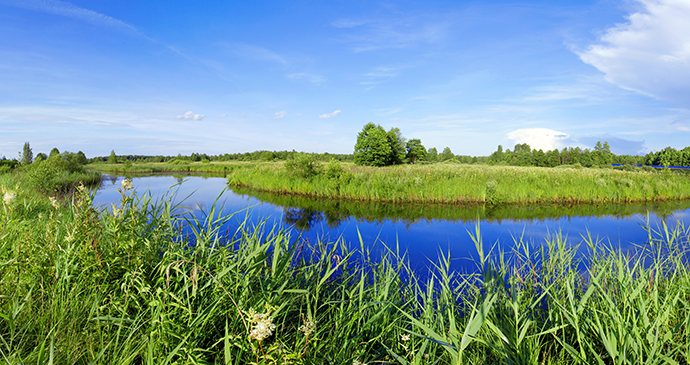
Berezinsky Biosphere Reserve
Now part of UNESCO’s World Network of Biosphere Reserves, this special place was originally opened in January 1925 to preserve and nurture another splendid natural environment, as well as to conserve and protect the valuable wildlife living there, notably beaver. Covering around 85,000ha and attracting around 20,000 visitors per year from within Belarus and abroad, this is a substantial area of wilderness. Here is a land of virginal primeval forests (mostly pine and spruce), marshland (one of the largest in Europe) and lakes, rich in diverse flora and fauna, sitting right in the middle of the watershed of the Baltic and Black seas. The areas of marshland are particularly beautiful. Small wooded islands rise above marsh plains as far as the eye can see. Thousands of years ago they were proper islands, washed by the waves of the vast glacial lake that is buried now under a thick and impenetrable layer of rich peat. The largest and longest river, the Berazhina, is an integral link in the system that connects the Baltic Sea to the Black Sea. In times gone by it was a very important trade route. Today, trade has been replaced by leisure and the river is populated with visitors retracing the routes taken by Vikings and Greeks in history.
Around 52 species of mammal live here, including brown bear, elk, wolf, otter, wild boar, lynx, the once rare (but now flourishing) beaver and even the extremely rare European bison, along with 217 species of bird (including the golden eagle and the seldom-seen black stork), ten of amphibian, five of reptile and 34 of fish. And mosquitoes. Clouds of them. The vegetation is also richly diverse, with more than 780 herbaceous varieties being found in the reserve, as well as over 200 varieties of moss and lichen.
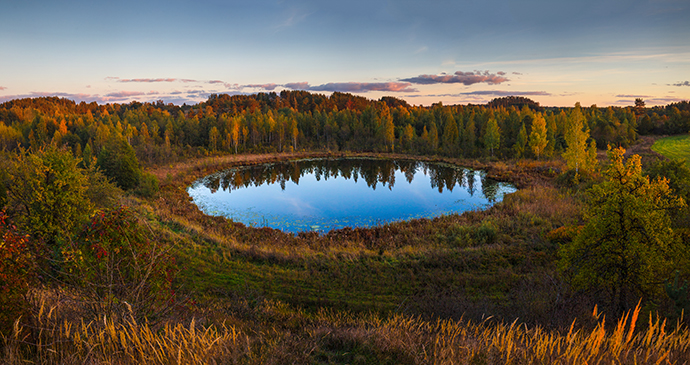
Braslav Lakes National Park
With the sprawling town of Braslav within its boundaries, this beautiful park of 70,000ha is located close to the border with Latvia, about 250km north of Minsk and slightly less northwest of Vitebsk, through Polotsk along the P14 road. Established in 1995, it is famed for the unique nature of its aquatic ecosystems. The southern part of the park is mostly lowland marsh and forest, while the central and northern parts consist of beautiful blue lakes interconnected by a labyrinth of hundreds of rivers and streams set in picturesque rolling hills. No fewer than 189 species of bird live here, including black stork, osprey, tern, bittern and ptarmigan. It is also possible to spot elk, wild boar, roe deer, beaver, fox, racoon, badger and wolf roaming free in their natural environment, although all are of course shy and evasive. There are also complexes consisting of large pens for closer study, although do bear in mind that these are enclosed spaces. Animals are not free to wander without boundaries and as a matter of principle, the difficulties of this concept speak for themselves. Inhabiting the lakes are 28 species of fish, such as eel, whitefish, whitebait, zander, pike, catfish, carp, bream, chub, turbot, tench, perch, gudgeon, loach, ruff and stickleback. The park is rich in flora (more than 800 species). The areas of forestry include birch, pine, fir, black elder and aspen.
Visitors can dip into various organised tours on horseback or by car, as well as on the water or by foot, lasting from one to several days. The pastimes of hunting and fishing are particularly well served. One of the most delightful trips is by launch across the limpid lakeland waters.
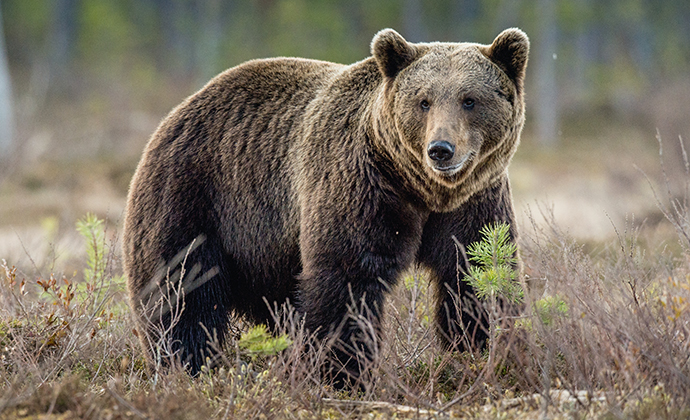
Byelovezhskaya Puscha National Park
First established as a national park in 1939 (although a ‘park’ has existed here since the Middle Ages), it joined the list of UNESCO World Heritage Sites on 14 December 1992, then in 1993 it was granted the status of Biosphere Reserve, affording unique opportunities for specialist ecological study. There are conference and library facilities here, together with accommodation for up to 100 visiting scientists.
Today, the park is an integral and important feature of around 1,700km2 of ancient primeval forest within Belarusian borders, although the woodland stretches across the border into Poland, which jointly administers the park with Belarus. Deeply worrying tales have reached my ears in recent times that extensive logging is in progress on the Polish side. This must be resisted, because the forest here is all that now remains of a vast canopy that once covered the whole of the huge northern European plain, the former home and playground of Polish princes and Russian tsars. In fact, the last private owners of the forest were the tsars of the Russian Empire, from 1888 to 1917. After the Revolution, it was nationalised and brought under the jurisdiction of the state. A number of the mighty oaks may be over 650 years old. One of them, ‘the Solitary Oak’, is specifically signposted within the park.
Today life here is calm and the reserve is home to around 212 species of bird, including corncrake, eagle owl, white stork and white-tailed eagle, along with 59 species of mammal, including wild boar, wild horse, roaming elk, beaver, lynx, fox, deer, wolf, otter, badger, mink, ermine, marten and, most famously, bison. By 1920, the European bison was almost extinct. Once to be seen roaming the great continental plain in their thousands, only a handful remained. But with careful management and controlled husbandry in the intervening years, numbers have increased to more than 2,500 in eastern Europe. Several hundred are known to inhabit the park and can readily be seen from the roads and paths.
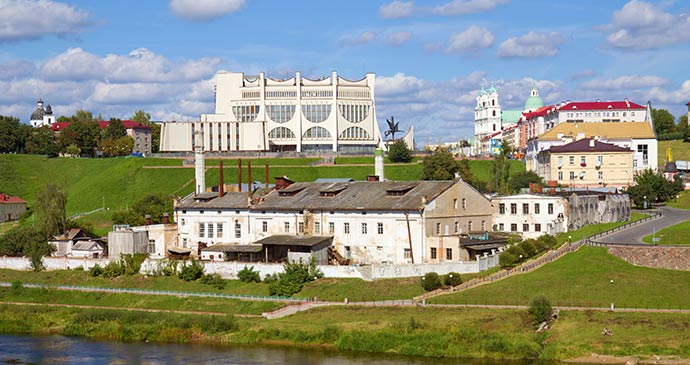
Grodno
The region of Grodno is situated in the northwest of Belarus and has borders with both Poland and Lithuania. The administrative and cultural centre of the region is the city of Grodno itself, with a population of 365,610. Situated 278km west of Minsk and just 294km east of Warsaw, it is only 20km from Poland and 40km from Lithuania. Records indicate that the city has been in existence for almost 900 years. Not surprisingly, given its location, it has a significant Polish and Lithuanian heritage.
The greatest wealth of the Grodno region consists of the leafy groves forming the magnificent tract of natural forestation that occupies more than one-third of its territory to the northeast and southeast of the city, either side of the historic town of Lida. Comprising both coniferous and mixed woodland, it is pleasing to see that pockets of the ancient virgin forests that once covered this whole continent have survived more or less intact here.
This is also a land rich in lakes, large and small, but all of them picturesque, with a reputation for crystal-clear waters. The renowned Avgustovski Canal also runs through the northwestern corner of the region for 22km on its meandering way to Poland. The charms of the canal and the many leisure services attendant upon it are promoted vigorously by the local tourism industry, which is particularly well geared up for incoming visitors from abroad.
The history of the region, characterised first by conflict and then by the ensuing peaceful coexistence of Baltic and Slavonic peoples, has left its mark on the territory. The original fortress of Grodno, built on the banks of the Nieman River in the 11th century, has now evolved into an elegant, thriving, bustling, energetic and cosmopolitan modern city, where more examples of Classical architecture have been preserved than in any other city of Belarus. Indeed, the national state government has declared the historical centre of Grodno a special architectural zone under the protection and jurisdiction of the state itself. Of the country’s major cities, it is perhaps Vitebsk and Grodno that best lend themselves to an appreciation of their charms, apparent if you meander through the streets at a leisurely pace, gazing at the richness of the buildings that surround you.
There are also many fine examples of architecture in the region, most notably the beautiful 16th-century fortress of Mir, the dramatic ruins of Novogrudok’s 14th-century castle and a number of unusual military churches. During the 15th and 16th centuries, many of the Eastern Orthodox churches were required to serve the dual purposes of worship and as places of fortified refuge against the attacks of aggressors, and many of those that are still standing look more like towered castles. The best examples of these fortress-churches can be seen in the villages of Synkovichy (built 1407) and Murovanka (1524). In Smorgon, the 16th-century Calvinist cathedral is well worth a visit. And for students of topography and geometrical surveying, two of the points of the Struve Geodetic Arc included in the five within Belarus on the UNESCO World Heritage List are to be found within the oblast, in the districts of Oshmyany and Zelva.
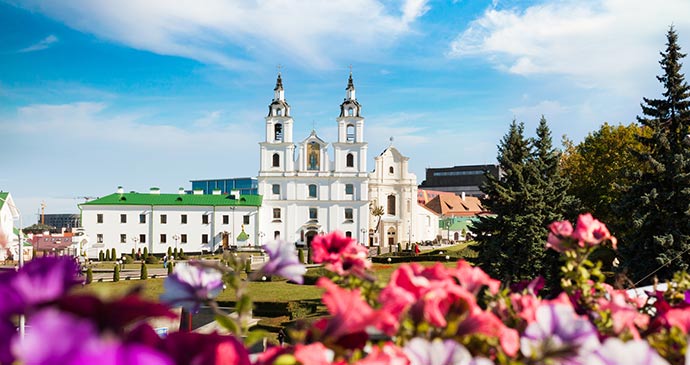
Minsk
Minsk is the capital and largest city in Belarus, with a population of 1,974,800 in 2017. As the national capital, it has special administrative status in the country and it is also the administrative centre of Minsk oblast. Perhaps surprisingly, given the geographical size and metaphorical significance of its giant neighbour, the Russian Federation, Minsk is also the headquarters of the Commonwealth of Independent States (CIS), which was formed on the breakup of the Soviet Union. In truth, however, the significance of this status is minimal. The CIS has always been a fluid federation, honoured more in concept than in reality.
Most capitals of the world are characterised by a high level of ambient noise and a jumble of activity wherever you look. Not so Minsk. For a city of nearly two million people, the atmosphere is universally calm. Outside rush hour, when there is gridlock at major junctions and drivers are impatiently leaning on car horns, ten-lane boulevards are often devoid of traffic. In many cities of the world, there is a feeling of claustrophobia as buildings close in on top of each other. But in Minsk, the skies are huge and there is a real sense of open space. Wherever you meander, vast and sweeping panoramas unfold before your gaze, all with a host of different sights. At times it feels you can stroll for ages in areas of parkland and not see another soul, but without feeling nervous in the process. The streets are spotlessly clean and free from crime or even antisocial behaviour. Access to all areas of interest to the visitor by public transport is simple and uncomplicated, not to say impressively efficient. Many of the sights can be reached on foot and in so doing, you will rediscover an activity that is largely lost in the West these days: that of promenading. This is because walking is seen as so much more than simply a mechanical act of propulsion from A to B. Rather, it is an art form to be savoured, with every footstep to be relished. Everywhere you look, even in the depths of winter and no matter what the time of day or night, you will see people strolling, apparently aimlessly, but locked in conversation and arm in arm. Here in Minsk (and indeed, everywhere in Belarus), teenagers mingle with families, young children, older people and young women on their own or in twos, just taking the air, enjoying the sights, chatting and relishing the fact that they have, for a short while, stepped off the merry-go-round of life.
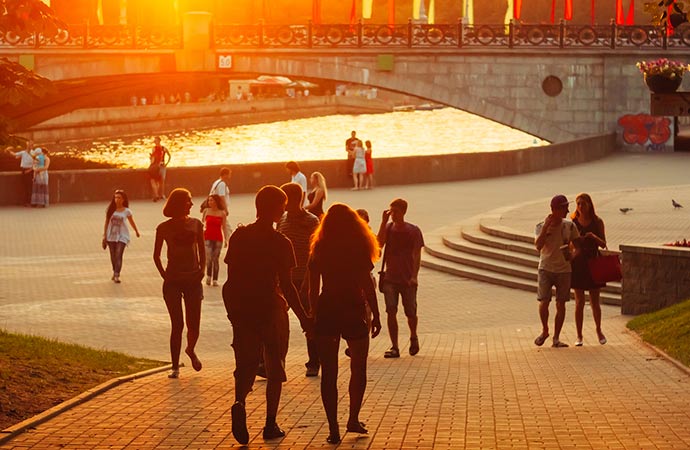
My favourite time to be in Minsk is on a Sunday, before breakfast. I always set the alarm early and get out on the street as soon as I can lever myself out of bed, just to walk and walk. The grandiose buildings and particularly the monuments to the heroism of the city and its people during the privations of war are all the more impressive if you can enjoy them in solitude and in silence. Often I ride the metro for hours with a multiple-journey card, picking stations at random and alighting to wander. My favourite treat to myself is to get out at Traktorny Zavod (Minsk Tractor Works), emerging from the subway a time traveller, launched back 50 years into the heyday of the Soviet Union. Monuments, flags, banners, billboards and the Stalinist architecture of the factory itself proclaim the glory of labour under Lenin’s authoritative gaze. And on Sunday you will have the whole place to yourself to meander as you please. Inner peace, serenity, a feeling of security and a rare connection with the soul, all on the streets of a major capital city? Count on it!
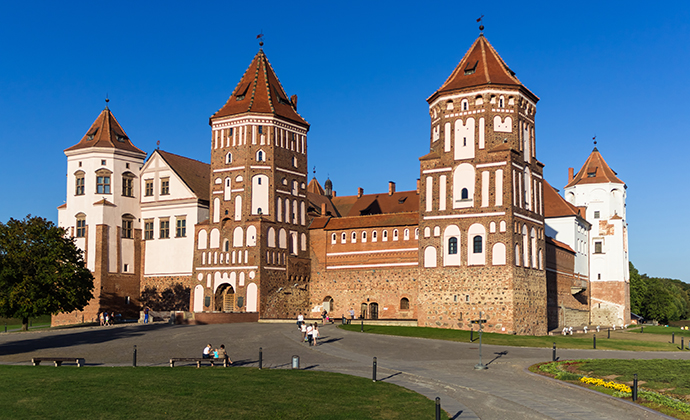
Mir Fortress
Situated on the edge of the town in a delightful setting overlooking a serene lake and built largely of stone and red brick, it is not only a powerful monument to the influence of the princes who commissioned its construction, but also very pleasing on the eye.
The walls and towers of the castle (still known today as the ‘medieval flower’) first appeared in the 1520s, followed by the construction of the Renaissance palace itself between the late 16th and early 17th centuries. After a battering during the war with Russia in 1655 and the later Northern War, it gradually fell further into disrepair, before a revival in the 1730s when a portrait gallery and ornate banqueting hall were added, together with a beautiful Italianate garden containing citrus, fig, myrtle, cypress, box, mahogany and laurel trees. The scent on the breeze of summer evenings must have been extravagant and intoxicating. Latterly, the complex suffered extensive damage in the Great Patriotic War, when a Cossack regiment was stationed here and a number of engagements took place in the vicinity. A very significant programme of restoration is now complete and this beautiful walled structure of five towers (after the first four, a fifth was added for security purposes in the centre of the west wall facing the road to Vilnius as the only means of access by drawbridge and portcullis) and a courtyard accommodates a small hotel, conference hall and traditional restaurant in addition to the museum of exhibits housed in various rooms throughout the building. Caution is needed when negotiating the steep, narrow and winding staircases which permit access to those parts of the castle that are open to the public, with some of the steps being quite large. It is possible to climb to the very top of the southwestern tower, the best-preserved of the five, from which there are extensive panoramic views over the town and surrounding countryside. The five floors currently house works of fine art.
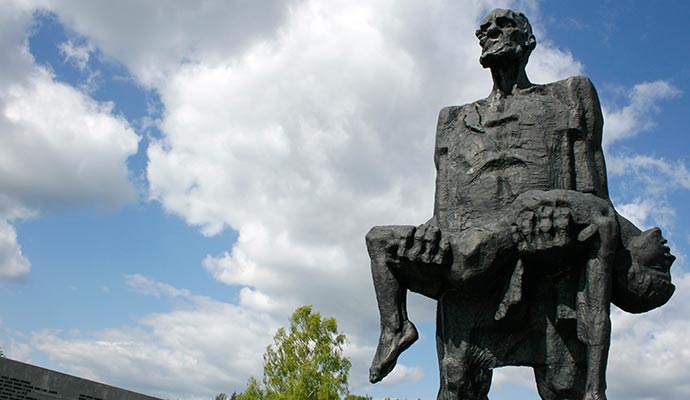
National Memorial Complex, Khatyn
If you take only one out-of-town trip while in Minsk, then do try to make it this one. Only 75km from the capital, this memorial complex bears witness to the horrors of Nazi barbarism during the Great Patriotic War. It was constructed on the site of the former village of Khatyn, which was razed to the ground in the spring of 1943 and its inhabitants brutally butchered. At the centre of the complex is a truly astonishing bronze sculpture, the 6m-high The Unconquered Man. Before you go, do visit the excellent English-language website for a full description of the terrible events in 1943 and for further details of the memorial complex that exists today.
The tragedy of Khatyn was not just an isolated episode in this tumultuous war, for the experience was replicated many times over on the territory of the Soviet Union. It is said that the inhabitants of 618 Belarusian villages were burned alive during the occupation in SS punishment operations against partisan groups. Of these villages, 185 were never rebuilt and have simply vanished from the face of the earth. Overall, every fourth Belarusian perished during the war: a total of 2.2 million people. This figure includes the 380,000 who were deported to Germany as slave labourers, never to return home. A staggering 209 cities and townships and 9,200 villages were destroyed. So catastrophic was the impact on the population that it did not recover to its pre-war total until 1971. Every visitor to Belarus is struck by the large number of war memorials that exist and the extent to which the conflict continues to dominate the national psyche to this day. A visit to Khatyn helps to place all of this into the right context.
So it is to the memory of all of these communities that the vast complex at Khatyn is dedicated. Covering a total area of 50ha, the memorial has 26 symbolic chimneys, each with a mournful, tolling bell, to mark the site of each of the 26 houses, the boundaries of which are delineated by low concrete walls with gates, all of them depicted as being open as a metaphor for the hospitality of Belarusian people. Also marked are the sites of the village wells. On the face of each chimney is a plaque bearing the names of each family member who lived there, from aged grandparents to babes only a few weeks old. In itself this is a truly sombre metaphor, for only the brick chimneys were left standing when the Nazis torched log houses in Belarusian villages.
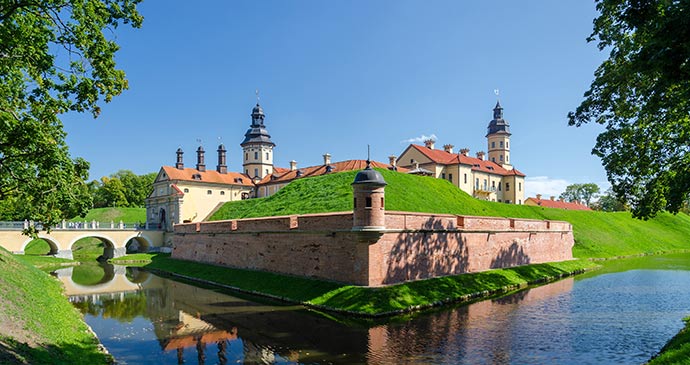
Njasvizh
Situated 120km southwest of Minsk and only half an hour by road from Mir and its charming castle (in Grodno region) is the delightful historic settlement of Njasvizh, one of the oldest in the country. Thought to have first been established as a settlement in the 13th century, historians believe that the town itself was founded around 1446. Though the new town is without charm, many of the oldest buildings have been retained in the historical area, and the former home of the Radzivili family is widely regarded as the most attractive palace that the country has to offer. The family’s ownership of the town began in the middle of the 16th century and was to last for more than 400 years, during which time it gained great fame for its prosperity. In 1586, the town was granted Magdeburg rights of self-government and determination, which was a catalyst for rapid economic development. Many trade guilds were established and it was no surprise that at the end of the 16th century it was almost completely rebuilt, the chaotic and haphazard layout of its medieval streets being replaced by the geometric design that remains to this day. The main street crosses the town from east to west. It was originally surrounded by earthen walls that were constructed to make the town a fortress. Some of them, most notably in the southeast, can still be seen. Over the centuries, many severe trials (such as plunder, fire and war) took their toll on the town but, through it all, the mighty Radzivili dynasty survived. The line finally ended in 1939, but not until it had first seen off not only the Great Lithuanian Principality, but also the might of the Russian Empire.
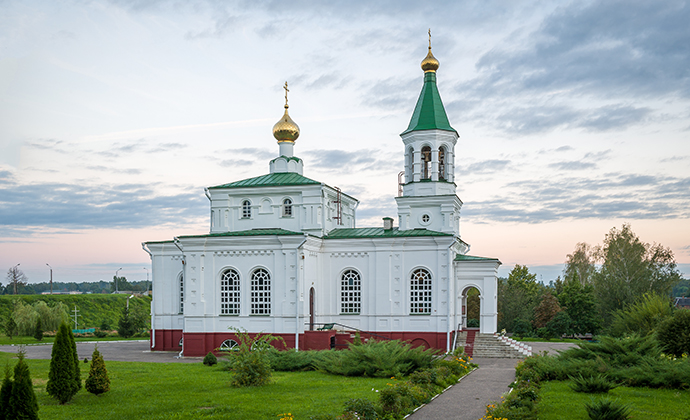
Polotsk
After Vitebsk itself, this is the region’s second-largest town (85,000 inhabitants) and one of the most attractive in all Belarus. On its doorstep is the urban sprawl of the larger and much less attractive town of Novopolotsk (‘New Polotsk’, population 102,000), constructed in 1958 as a base for the local oil industry. There’s nothing for you to see there but happily, lovely Polotsk has riches to spare. Located 105km northwest of Vitebsk along the A215 road, this historic settlement (one of the oldest cities in the whole of eastern Europe) has a beautiful riverside location on the Western Dvina, which also flows through Vitebsk. It is often referred to as ‘the city of all Belarusian cities’, with a rich literary heritage. Poet, translator and teacher Simeon of Polotsk was born here, as well as the great humanist and translator of the Bible, Francisk Skoryna. This includes my good friend Larissa Yatskevich, a tour guide and former university lecturer, who told me once, ‘It all started here for Belarus!’ Interestingly, it was only after the collapse of the Soviet Union that people began to learn of such things; until then it appears that only post-1917 history was taught in schools.
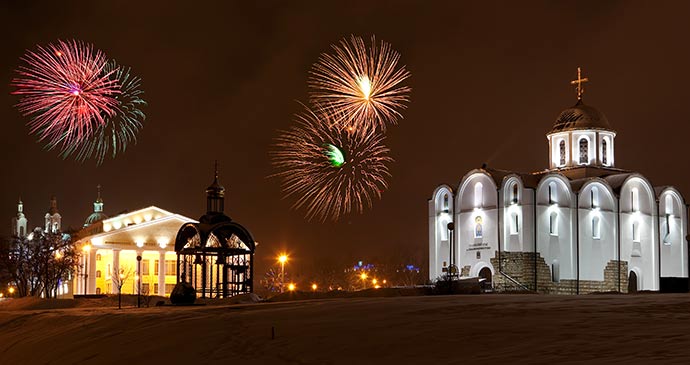
Vitebsk
Bordering Lithuania, Latvia and Russia, the Vitebsk region is situated in the north and northeastern part of Belarus and occupies almost one-fifth of the country’s total territory. The administrative centre of the oblast is the charming and elegant city of Vitebsk, birthplace and long the home of artist Marc Chagall, with a population of around 378,000. Situated on the Western Dvina River (where the Vitba and Luchosa rivers also converge) and famed for its rich cultural and scientific traditions, it’s one of my favourites of the country’s six cities.
This whole area is the country’s lakeland, with 11 out of the 19 major lakes of Belarus being found here. The most precious gem in the entire area is undoubtedly the collection of Braslav Lakes, 50 of them in total, covering a surface area of 130km2, all incorporated into a national park, with rare species of plants and wildlife preserved in their natural environment. And situated in the southwest of the region is the stunning Berezinsky Biosphere Reserve, over 85% of which is primeval virgin forest.
Vitebsk is widely regarded as being second only to Minsk as the cultural capital of the country and then not by much. It is the location of the popular and much-loved Slavianski (Slavic) Bazaar, an international song and culture festival that takes place annually in the open air in late July and early August. Most of the musical programme is devoted to a celebration of ethnic Slavic music.
As well as the bazaar, the city also hosts 27 other annual festivals celebrating the performing arts, including modern dance and chamber music. At times, it seems the entire city morphs into festival mode. And the original School of Arts founded in 1919 by Marc Chagall continues to thrive. Overall, there is little doubt that the reputation of Vitebsk as an international centre for the promotion of the performing arts and fine art is assured.
Related books
For more information, see our guide to Belarus:
Related articles
Covering even more of the world than our guidebooks, forests are ubiquitous but almost always different.
With one foot still in its Soviet past, Belarus might not be the most obvious choice for travellers, but its isolation is at the heart of its appeal.
Here’s why you should consider this oft-overlooked eastern European capital for your next city break.
Belarus is a country with a rich and fascinating history, and its historic sights are some of its most impressive attractions.
There are many national parks in Europe that remain fairly unknown. Here you can discover 14 of the best. Why miss out on visiting somewhere spectacular?
